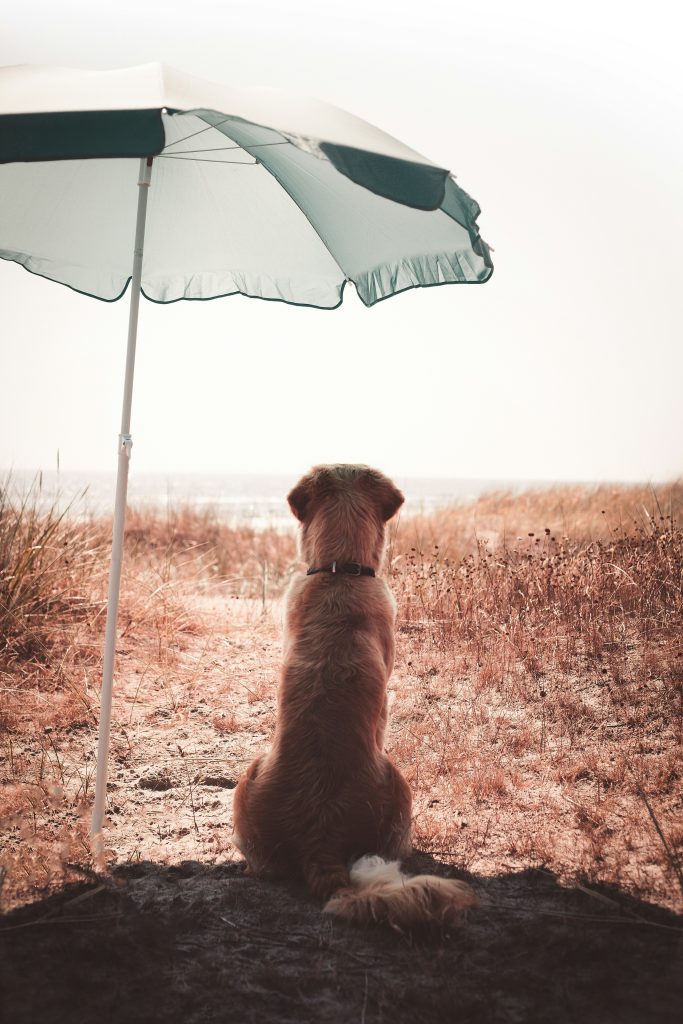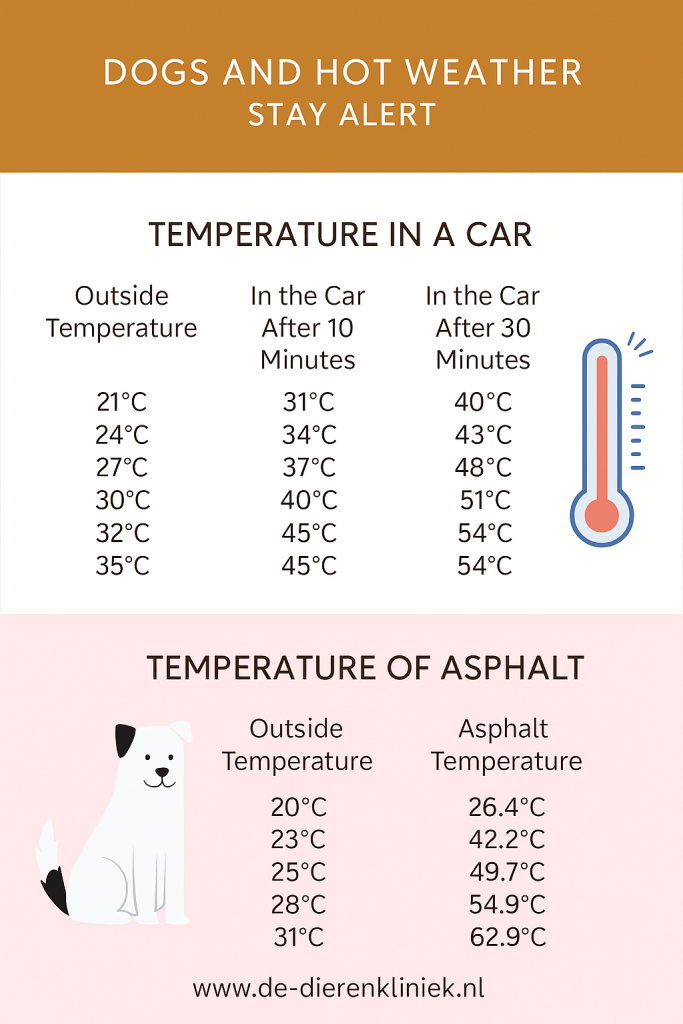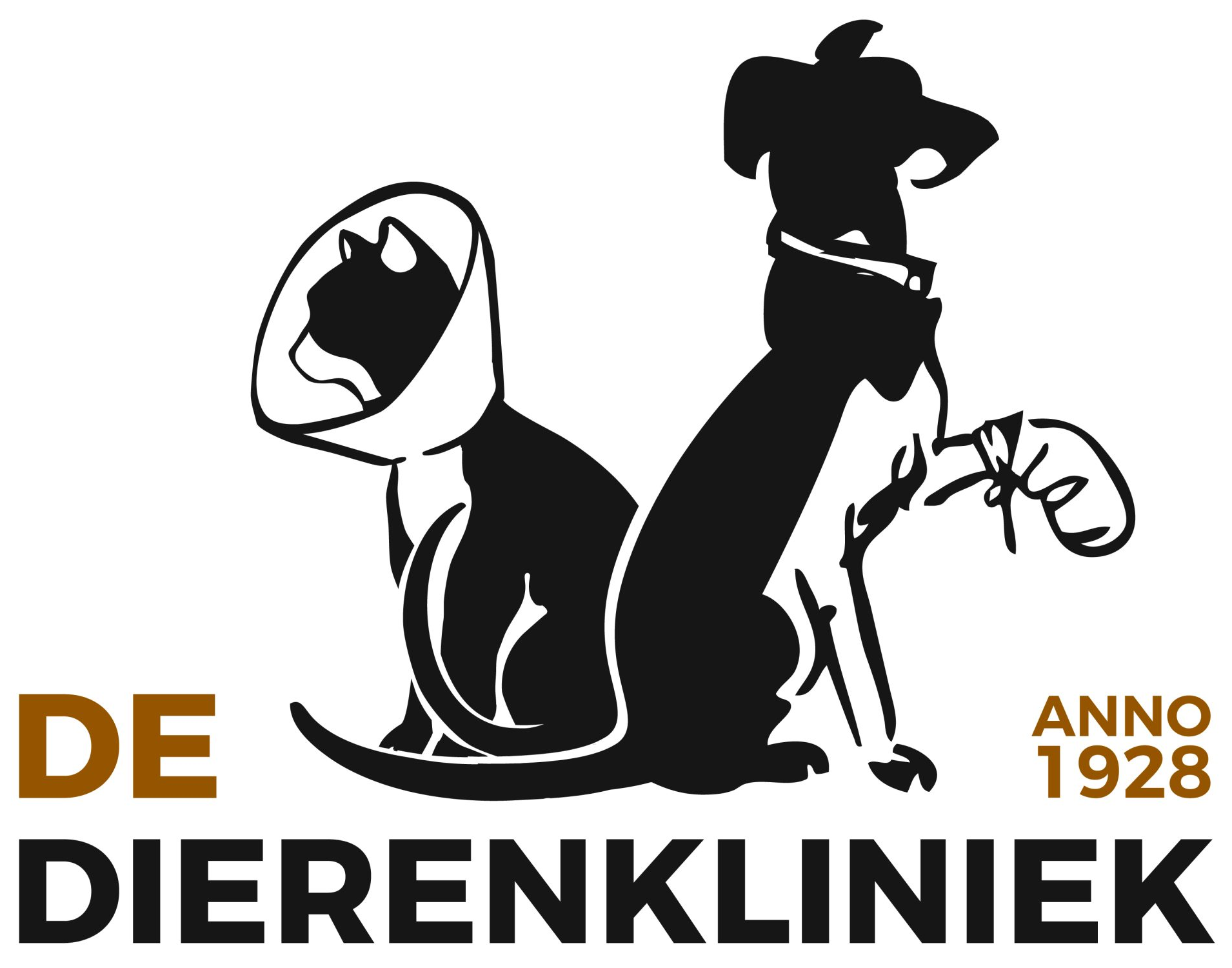When is it too hot for my dog?
Wonderful when the sun starts shining again! Life starts happening more outside, and all sorts of positive chemicals are produced in our brains. But not all dogs are as happy as we are about the warm weather. To keep summer fun for your dog, too, and prevent overheating, there are a few things you need to pay close attention to.
Dogs and heat

Dogs are sensitive to heat. They have fur that insulates and cannot sweat as we do. They regulate cooling through the tongue by panting and, to a lesser extent, through the soles of their feet. Thus, they do not lose their heat easily. In hot weather, your dog’s body temperature may rise too high, causing them to go into heat shock. In this, the body temperature is so high that the proteins in the blood and in the cell structures change. As a result, the blood in your dog’s veins becomes viscous. The blood then cannot be pumped around properly, which can lead to damage to the dog’s organs, heart and brain, or even death.
It is difficult to say at what temperature it is too hot outside for the dog, this varies from dog to dog. The advice is to be alert above 15 degrees celcius. Look at the circumstances; if it is cloudy and there is a breeze, then 15 degrees Celsius is no problem, but if you are sitting in full sun and out of the wind, then 15 degrees can already be too warm for many dogs.
How do you know if a dog is too hot?
Dogs can get too hot quickly. The following symptoms can be signs of this:
- The dog is panting heavily and possibly drooling
- The dog moves slowly and/or is lethargic
- The dog has little or no appetite
- The dog starts vomiting
- The dog feels hot
How do you know if a dog is overheated?
The normal body temperature of dogs is between 38 and 39 degrees celcius. Puppies have a slightly higher temperature, up to max 39.5 degrees. When dogs are too hot their body temperature rises. We speak of overheating when the body temperature is 41 degrees or higher. Symptoms of overheating (heat shock), in addition to excessive body temperature and the symptoms you see when your dog is too hot, are the following:
- The dog has an excessively rapid heartbeat and breathing
- The mucous membranes are red
- The dog is short of breath
- The dog is hardly or not reacting to stimuli
What to do when a dog has heat shock?
If your dog has heat shock, it is essential that you help your dog cool down as soon as possible. You can do this as follows:
- Take the dog to a cool, shady place
- Cool the dog by wetting him or her with running water. Caution! Do not use ice-cold water for this; too great a difference in temperature can cause cardiac arrest in a dog in shock. In particular, wet the head, belly, groin, paws and ears. Once the dog has gotten used to the temperature difference, you can completely wet the dog.
- If there is a fan nearby, use it. An air conditioner in a car can also be used. Focus it especially on the head, so the dog can breathe in the cool air and evaporate heat through the tongue.
- Keep a close eye on the temperature, as the dog should not cool down too much. Especially with small dogs this is a lurking issue. If the dog’s temperature drops, stop cooling it and dry it well.
- Let the dog drink small bits of lukewarm water. Note: do this only if the dog is conscious
If your dog is, or has been, in heat shock, always consult your veterinarian!
Which dogs are more at risk of overheating?
There are certain high-risk groups that are especially sensitive to heat. These high-risk groups are:
- Older dogs and puppies
- Overweight dogs
- Dogs with short snouts, such as the French Bulldog and the Pug
- Dogs with dark and/or thicker coats
- Dogs with heart disease and/or lung disease
Tips for keeping your dog cool
Limit physical activity
On hot days, the advice is to limit the dog’s physical activity. Do not let your dog run alongside a bicycle or take long walks. Don’t walk during the hottest part of the day, but in the morning or evening, and always make sure you have plenty of water. Also, try not to stimulate your dog’s exercise, so don’t play with a ball or stick.
Provide adequate shade and cooling
Create plenty of shaded areas and make sure drinking water is always available. It is best to give drinking water that is room temperature, never give ice cold water. There are also several tools for sale that can help provide your dog with cooling, such as a special cooling mat that they can lie down on, a cooling jacket or a cooling collar.
Never leave your dog behind in the car
We can’t say it often enough: never leave your dog in the car! People underestimate how quickly temperatures can rise in a car. Do you see a dog in hot weather in a (closed) car? See if the owner is nearby. Can’t find the owner? Then alert the police and animal ambulance as soon as possible.
Beware of dog paws on warm asphalt
Asphalt heats up incredibly quickly in the sun to very high temperatures. Dogs can burn the soles of their feet. You can check the heat of the asphalt with your hand. Hold it still for 7 seconds, is it too hot? Then it is too hot for your dog’s feet. Also be careful with other kinds of dark paving stones and sand.
Skin and coat care
A dog’s coat can provide insulation from both heat and cold. You can encourage this by brushing your dog regularly to remove loose hair. In this way, the undercoat reduces, allowing the dog to lose heat more easily. For dogs with a longer coat, you can also choose to shave it shorter in the summer. Consult with a groomer or veterinarian first, as this is not a good thing to do for all coat types. The skin of dogs, as with humans, can be burned by the sun. In particular, areas with little hair, such as the nose, the edges of the ears and the belly, are sensitive to sunburn. There is special sunscreen for dogs that can help with this. Never use sunscreen for humans. This can be harmful if the dog licks it or irritate the skin.
Beware of blue-green algae and botulism
Lovely of course, swimming in hot weather! This is also definitely a good way for your dog to cool off. Just be careful not to let your dog swim if there is blue-green algae or Botulism. Blue-green algae can cause gastrointestinal distress, skin irritation and mucous membrane irritation, among other things. Botulism can cause severe gastrointestinal symptoms, muscle weakness, paralysis and in some cases even death. The website www.zwemwater.nl shows where you and your dog can swim safely.
More information
Which dog breed is right for me?
A new puppy!
Clipping nails
Hereditary diseases
My dog is in heat
Pregnancy and delivery
Travelling with your dog
Travel sickness
When is it too hot for my dog?
When is it too cold for my dog?
Poisoning
Fear of fireworks
Brushing your dog’s teeth
First aid for your dog
Ointment of ears
Temperature measurement
Senior dog
Putting your dog to sleep


